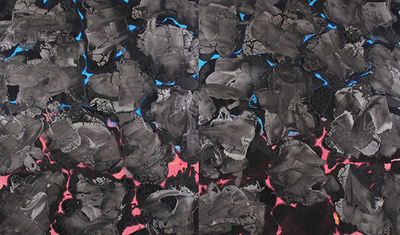CALIFORNIA DREAMING: ED MOSES, BILLY AL BENGSTON & ED RUSCHA

Ed Moses, Bronco, 2002, Acrylic on canvas, 78 x
132″. Courtesy of the artist. © Ed Moses

Billy Al Bengston, Skinny’s 21, 1961, oil on canvas,
42 x 40″. Courtesy of the artist. © Billy Al Bengston.
The story of the Ferus Gallery, headquarters of the LA Cool School, begins at a hot dog stand.
In late 1956, Walter Hopps and Ed Kienholz met for lunch on La Cienega Boulevard, in Los Angeles, and drew up a contract on a hot dog wrapper: “We will be partners in art for five years.” It was an unlikely pair: Hopps was a student of biochemistry with no formal training in art history, and Kienholz was an artist and handyman who lived “off the fringes of society like a termite,” as he put it. Yet, within a year, Hopps and Kienholz had opened a gallery in an alleyway off La Cienega Boulevard that, perhaps more than any other institution, established Los Angeles as a hub of modern art.
The Ferus Gallery, and the sun-baked aesthetic of the LA Cool School, is the subject of an exhibition at the New Britain Museum of American Art, in Connecticut, that brings together the work of three painters: Ed Moses, Billy Al Bengston, and Ed Ruscha. Organized by guest curator Thomas Krens, Director Emeritus of the Solomon R. Guggenheim Foundation, the show samples the formal hijinks of a coterie of artists who infused Abstract Expressionism with the carefree ethos of California. Each artist has a distinctive voice, from the color-saturated wordplay of Ruscha to the hard-edge insignia of Bengston to the aleatory operations of Moses, who regards his work as a function of “chance and circumstance.” What they share: a love of cold beer and beautiful girls.
“We all used to hang out at a place called Barney’s Beanery,” said Moses, 91, referring to a tavern in West Hollywood where artists affiliated with the Ferus Gallery gathered almost every night. “We competed and told lies and chased after similar women…We were a small group of guys who thought we were better than everybody else, and it ends up that we were at least as good.”
Before the Ferus Gallery was established, there was no Los Angeles art scene to speak of beyond cheap imitations of Pablo Picasso and Paul Klee. Abstract Expressionism, ascendant in New York, was viewed with suspicion by civil authorities, who believed it to be symptomatic of a global Marxist contagion. In the early 1950s, the Los Angeles Board of Supervisors scuttled a citywide arts fair on the grounds that it was a vehicle for “Communist infiltration.” Thus, many of the artists represented by the Ferus Gallery regarded themselves as dissidents or revolutionaries, a scrappy band of beatniks with no time for naysayers.
“We were all aggressive pricks,” said Bengston, 82. “I can honestly state that we were a pretty mean-ass group…We attacked anybody that attacked us, and we attacked each other. It was sort of a sport: if somebody hit the ball hard to you, you hit it back harder.”
In the studio, this competitive spirit motivated the artists to devise a formal language to match the cultural landscape of Los Angeles, a compound of hedonism, beach culture, and the cult of the chrome-trimmed automobile. Bengston’s Skinny’s 21 (1961) presents a schematic rendering of a motorcycle enclosed in a tangerine bubble. Moses’s Gargo (1988) makes explicit the artist’s debt to Abstract Expressionism by tracing an arabesque pattern in a muddy palette. “My hand is just like a caterpillar that crawls across the surface,” Moses said. “I dip my hand into a color, and then I mark the surface with an undulating, continuous line.” And, Ruscha’s Cold Beer, Beautiful Girls (2009) harkens back to the spirit of the age with a sly allusion to the pursuit of pleasure.
When Bengston, Moses, and Ruscha first came on the scene, their counterparts in New York scoffed at the laidback attitude of the LA Cool School. Yet, this played to the advantage of the three painters, allowing them to challenge formal conventions without the expectation of fame, riches or critical acclaim.
“Back then, there was absolutely no activity in terms of buying,” said Bengston. “We were just trying to have a good time—there was nothing else.”
